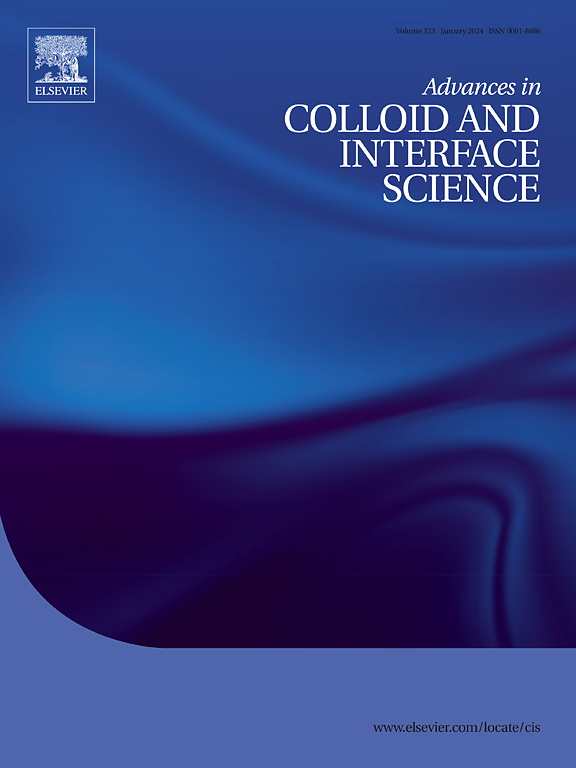估计流体-固体界面自由能的润湿性:分子模拟方法的综述
IF 19.3
1区 化学
Q1 CHEMISTRY, PHYSICAL
引用次数: 0
摘要
流固界面自由能(IFE)是影响润湿行为的基本参数,在广泛的工业应用中起着至关重要的作用。通过实验和半经验方法获得可靠的流固IFE数据仍然具有挑战性,并且缺乏可访问的计算工具限制了第一原理理论方法的适用性。近年来,人们发展了多种分子模拟方法来测定流固耦合寿命。这篇综述对这些技术进行了全面的总结和批判性的评价。介绍了各种模拟方法的发展、基本原理和实现,包括机械路线,如接触角方法、使用Bakker方程的技术和Wilhelmy模拟方法,以及热力学路线,包括劈裂壁方法、Frenkel-Ladd技术和测试体积/面积方法。这些方法可用于计算各种流固界面性质,包括IFE、相对IFE、表面应力和表面张力,尽管这些性质在文献中通常不加区分地使用。此外,回顾了这些方法的应用,以深入了解不同系统中流固界面能的行为。我们还举例说明了基于navascusamus理论和Berry和Bakker方程的两种流体-固体生命动力学解释。结果表明,基于这两种解释的模拟方法是相同的。本文提倡广泛采用分子模拟方法来估计流固耦合过程,这对于提高我们对各种化学体系中润湿行为的理解至关重要。本文章由计算机程序翻译,如有差异,请以英文原文为准。

Estimating fluid-solid interfacial free energies for wettabilities: A review of molecular simulation methods
Fluid-solid interfacial free energy (IFE) is a fundamental parameter influencing wetting behaviors, which play a crucial role across a broad range of industrial applications. Obtaining reliable data for fluid-solid IFE remains challenging with experimental and semi-empirical methods, and the applicability of first-principle theoretical methods is constrained by a lack of accessible computational tools. In recent years, a variety of molecular simulation methods have been developed for determining the fluid-solid IFE. This review provides a comprehensive summary and critical evaluation of these techniques. The developments, fundamental principles, and implementations of various simulation methods are presented from mechanical routes, such as the contact angle approach, the technique using Bakker's equation, and the Wilhelmy simulation method, as well as thermodynamic routes, including the cleaving wall method, the Frenkel-Ladd technique, and the test-volume/area methods. These approaches can be applied to compute various fluid-solid interfacial properties, including IFE, relative IFE, surface stress, and superficial tension, although these properties are often used without differentiation in the literature. Additionally, selected applications of these methods are reviewed to provide insight into the behavior of fluid-solid interfacial energies in diverse systems. We also illustrate two interpretations of the fluid-solid IFE based on the theory of Navascués and Berry and Bakker's equation. It is shown that the simulation methods developed from these two interpretations are identical. This review advocates for the broader adoption of molecular simulation methods in estimating fluid-solid IFE, which is essential for advancing our understanding of wetting behaviors in various chemical systems.
求助全文
通过发布文献求助,成功后即可免费获取论文全文。
去求助
来源期刊
CiteScore
28.50
自引率
2.60%
发文量
175
审稿时长
31 days
期刊介绍:
"Advances in Colloid and Interface Science" is an international journal that focuses on experimental and theoretical developments in interfacial and colloidal phenomena. The journal covers a wide range of disciplines including biology, chemistry, physics, and technology.
The journal accepts review articles on any topic within the scope of colloid and interface science. These articles should provide an in-depth analysis of the subject matter, offering a critical review of the current state of the field. The author's informed opinion on the topic should also be included. The manuscript should compare and contrast ideas found in the reviewed literature and address the limitations of these ideas.
Typically, the articles published in this journal are written by recognized experts in the field.

 求助内容:
求助内容: 应助结果提醒方式:
应助结果提醒方式:


